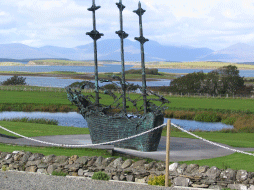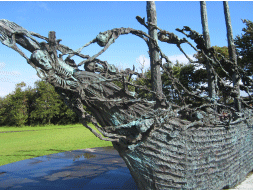|
The Irish in Yates County
Yates Past - March 2005
| |
 |
| |
|
| |
 |
| |
|
St. Patrick’s Day is upon us once again and it’s a good time to think about the role that Irish immigrants had upon the development of Yates County in the mid-19th Century. My wife and I toured western Ireland this past September. Near Westport in County Mayo, we climbed part of Croagh Patrick, the mountain from which St. Patrick was said to have driven the snakes into the sea. At the base of the mountain is a sculpture which serves as a memorial to the Great Famine of the 1840s. From a distance, the sculpture (which is named “Coffin Ship”) appears to be just a three-masted sailing ship but getting closer to it, one can see that the artist incorporated what looks like human skeletons into the rigging of the ship. It symbolizes the million plus Irish people that died between 1845 and 1850, as well as the million plus who emigrated to other parts of the world. Most of those who fled Ireland at that time came to the United States. In 1846, more than 100,000 Irish immigrants entered the U.S., but the peak years were in the early 1850s when annual numbers exceeded 200,000. Although many of them came through Boston and New Orleans, for most the port of entry was New York City. That was forty years before Ellis Island was opened. Processing of immigrants at that time was done in a building called Castle Garden which was located at the Battery on the southern tip of Manhattan. From there most went into the Irish neighborhoods of southern Manhattan made famous in a recent movie “The Gangs of New York”. Many, being from rural areas of Ireland, quickly moved inland. The Hudson River to Albany and the Erie Canal westward provided an avenue for many Irish immigrants to come into the farming areas of central and western New York.... including Yates County.
By 1850, there were just over 300 Irish-born people living in Yates County. The vast majority were in the village of Penn Yan, living along Jackson Street and across the outlet/canal near where Franklin and Sherman Streets are today in an area that became known as “Dublin”. Ten years later, the number of Irish-born people in the county more than doubled to over 700 (about 4% of the total population). The greatest concentration was still in Penn Yan, but more than half were scattered across the farm areas of the different towns.
They brought unskilled labor to an area that was rapidly developing agriculturally and industrially and was in need of it. In the 1860 Census, 302 Irish-born men listed occupations. Of them, 80% put “farm laborer” or “day worker”. Of the 125 Irish-born women who listed occupations, all but two put “domestic servant”.
They also brought Roman Catholicism to Yates County. The first Catholic Church in the county, St. Michael’s in Penn Yan, was built in 1850 on land given by Abraham Wagner on what is now Keuka Street . The driving force behind the founding of the parish was Thomas Hendricks, an Irish-born meatcutter with a large family. The early parishioners were mostly Irish and the parish priest in 1860 was Patrick McKenna....born in Ireland. A few years later, 1n 1853, St. Mary’s Church in Rushville was organized.
These early Irish immigrants to Yates County were not welcomed with open arms by the established population. Not only were they “foreign” amidst “native-born” New Yorkers, but they were Roman Catholic in a strongly Protestant area that had recently experienced a wave of religious revival and evangelism. When the men became citizens and voted, they almost all voted Democrat in an area dominated by Whig/Republican politics. Finally, at a time when the temperance movement was starting to take hold in Yates County, the Irish were notorious imbibers of whiskey. The result was that the majority of people in Yates County had a low opinion of their Irish neighbors.
When the Civil War came and volunteer regiments were formed in Yates County, many Irish-born men enlisted with enthusiasm. Military service included the promise of accelerated citizenship. In fact, it was the Civil War that started the uneven process of moving Irish immigrants into the mainstream of American life. Irish individuals and Irish regiments performed admirably during the war but it was the rapidly expanding economy during the late 1800s that provided Irish-born people with economic and political opportunities....and eventual acceptance. By the 1892 state census, the Irish were still the largest foreign-born group in Yates County but their economic, social, and political position had improved greatly.
By Rich MacAlpine
|
